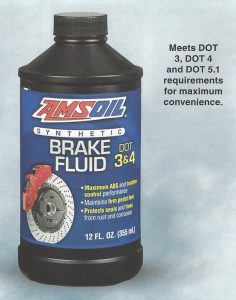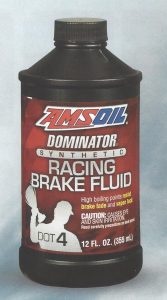The U.S. Department of Transportation (DOT) classifies brake fluid into four main categories:
- DOT 3
- DOT 4
- DOT 5
- DOT 5.1
Sorting through the different categories and understanding the applications for which they’re recommended can be confusing. In this article, we provide the info you need to understand the differences.
Brake Fluid Differences
The primary differences between the categories of brake fluid are …
- Wet boiling point
- Dry boiling point
- Fluid composition
Boiling Point Defined
The brake fluid’s boiling point is its most important characteristic. It indicates the temperature at which the brake fluid vaporizes. The higher the DOT classification, the higher the boiling point (see the chart), thus the better the fluid is at resisting heat, which is vital to safety and performance.
Braking generates intense heat between the brake pads and rotors. The heat can vaporize the brake fluid, causing it to become compressible, which leads to a spongy feeling when you apply the brakes.
Brake Fade Reduces Performance
It also leaves gas in the brake lines, which is compressible, leading to a soft pedal. In racing and performance-driving circles, this is known as brake fade, and it’s something drivers want to avoid. To drive as effectively and safely as possible, the driver must be confident that the brakes will perform on lap 10 as they did on lap one.
Brake fade can also come from the brake pad/rotor interface. The pads release gasses, which reduce contact
between the pads and rotors. High-end rotors are slotted and drilled to release gasses quicker, limiting fade.
Brake Fade Isn’t Just For Racers
Brake fade can also occur in non-performance applications. For example, descending a steep hill, especially when hauling a heavy load or towing a trailer, can generate tremendous heat if you ride or pump the brakes.
By the time you reach the bottom, your brake pedal may go nearly to the floor. Likewise, taking a spirited drive on a winding road can also invite fade if you’re a little too aggressive on the brake pedal.
What’s The Difference Between The Fluid’s Wet And Dry Boiling Points?
The dry boiling point is determined using fresh fluid straight from a new container. The fluid’s wet boiling point is determined using fluid that’s been contaminated with 3.7 percent water, thus it’s always lower than the dry boiling point.
The fluid’s wet boiling point is a more accurate reflection of what happens in the real world.

Brake fluid is hygroscopic, meaning it absorbs water (except silicone-based DOT 5 brake fluid). DOT 3 fluid, for example, can absorb up to two percent water every year. Moisture can enter the system when you remove the reservoir cap to add fluid, through worn seals and even through the rubber brake lines themselves. Thus the fluid’s wet boiling point is the number that more accurately represents what’s really going on in your vehicle.
Since brake fluid can wear out, it’s vital you change it periodically. Otherwise, not only will your brakes become spongy and unsafe, the moisture will slowly corrode metal components.
A good rule of thumb is to change the brake fluid every other year in passenger vehicles, and at least every year in racing vehicles. The AAA says 88 percent of motorists overlook brake maintenance.

General Recommendations
Each category of brake fluid is typically recommended for specific applications. The following provides guidelines, but consult the AMSOIL product guides for specific recommendations.
- DOT 3 is the most common type of brake fluid used in cars and trucks today and provides excellent all-around performance for most applications. It is compatible with DOT 4 and DOT 5.1.
- DOT 4 is gaining popularity due to widespread use of anti-lock braking systems and traction control, which benefit from its lower viscosity. It’s also excellent for racing applications. DOT 4 is compatible with DOT 3 and DOT 5.1.
- DOT 5 brake fluid is silicone, meaning it doesn’t absorb water. It’s not compatible with the other brake fluids and is used mostly in classic cars that remain in storage for long periods and need a brake fluid that doesn’t absorb water.
- DOT 5.1 is used in high-performance and heavy-duty applications due to its high boiling point. It’s compatible with DOT 3 and DOT 4 fluid.
We formulate two different brake fluids for passenger car/light-truck and racing applications. Their synthetic formulations and premium additives deliver excellent braking performance while fighting corrosion for long brake-system life.
AMSOIL DOT 3 and DOT 4 Synthetic Brake Fluid (BFLV)
- Maximum ABS and traction-control performance: Low-viscosity, specially designed fluid for high-performance passenger car, light truck and powersports applications.
- Firm brake pedal feel: Maintains low compressibility in severe operating conditions, resulting in consistent brake pedal feel.
- Helps extend the life of essential components like calipers, wheel cylinders, seals, lines, master cylinders and ASS control valves.
AMSOIL DOMINATOR® DOT 4 Synthetic Racing Brake Fluid (BFR)
- Provides vapor lock protection through high boiling points.
- Resists brake fade common in racing applications for a confident brake feel all the way to the finish line.
- Nitrogen blanket added to avoid moisture absorption and prevent contamination during manufacturing and storage.
AMSOIL Synthetic Brake Fluid FAQ’s
Can I use AMSOIL DOT 3 & 4 Synthetic Brake Fluid in a DOT 3 application?
Yes, DOT 3 and DOT 4 fluids are each glycol-ether based. AMSOIL DOT 3 & 4 Synthetic Brake Fluid is a DOT 5.1 product, exceeding the specifications of DOT 3 and DOT 4. Additionally, its 5.1 formula provides better protection against water contamination. Rather than two separate products, we elected to have one formula that performs best in all three applications.
Why is AMSOIL DOT 3 & 4 Synthetic Brake Fluid recommended for powersports applications rather than AMSOIL DOMINATOR DOT 4 Synthetic Racing Brake Fluid?
DOMINATOR DOT 4 Synthetic Racing Brake Fluid is engineered for racing applications that require protection against extreme heat. AMSOIL DOT 3 & 4 Synthetic Brake Fluid is recommended for (non-racing) powers ports applications that require a DOT 3, 4, or 5.1 product. AMSOIL DOT 3 & 4 Synthetic Brake Fluid also features a low viscosity, improving cold-weather performance and ABS and traction-control responsiveness.
Can AMSOIL DOMINATOR DOT 4 Synthetic Racing Brake Fluid be used in ABS systems?
Yes, in racing applications where ABS systems are used, DOMINATOR DOT 4 Synthetic Racing Brake Fluid is recommended.
Check out the AMSOIL Catalog for more quality AMSOIL products.
Reproduced With The Permission Of AMSOIL INC. All Rights Reserved.
For more information or pricing on the quality line of AMSOIL Products contact SLS Associates. Whether you are a Consumer, Retailer, or Commercial Business, we will answer your questions, explain any options and you take it from there. If you choose to try AMSOIL products we will give you our best price and you make the decision. No pressure. It’s your choice.
Click Here if you would like to browse the current AMSOIL Catalog


